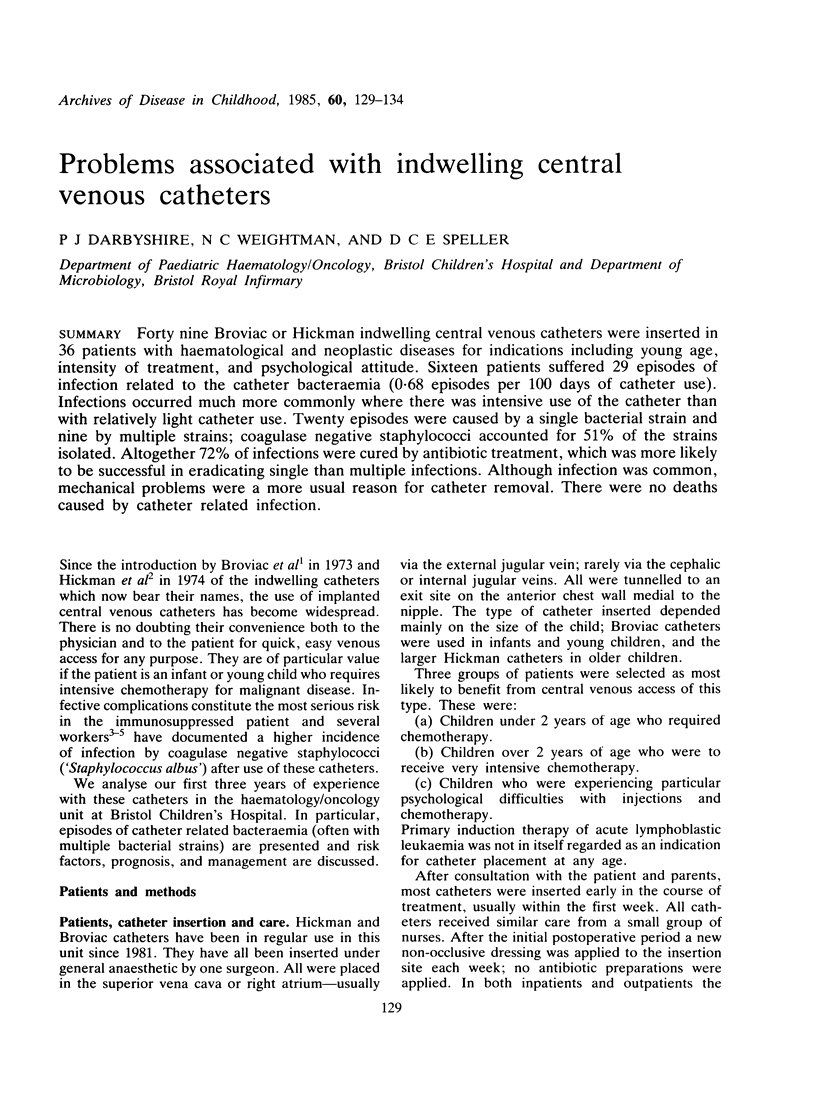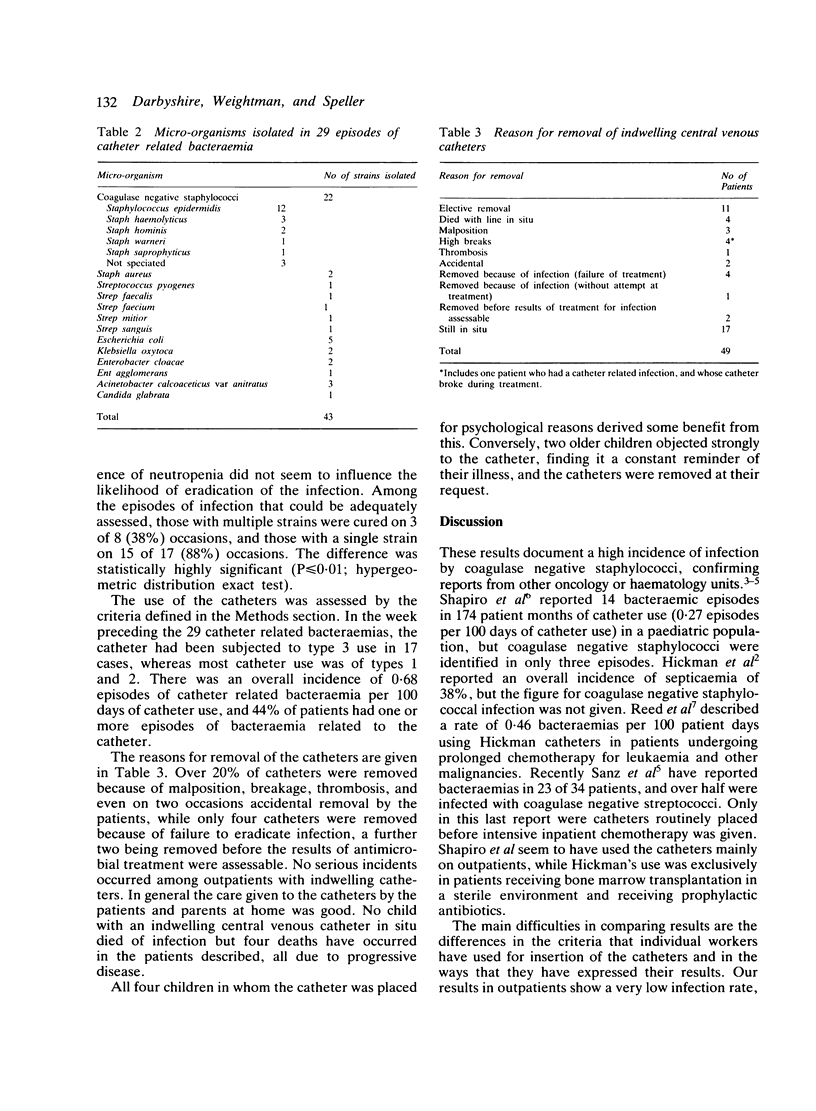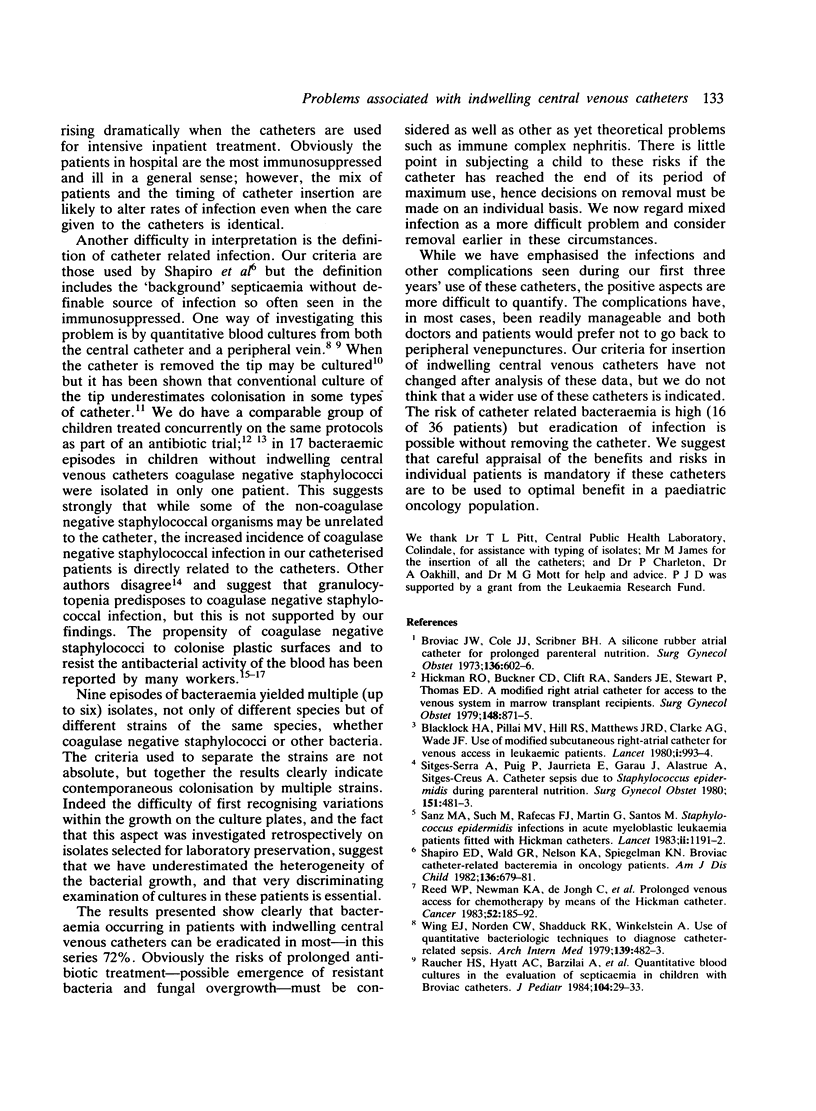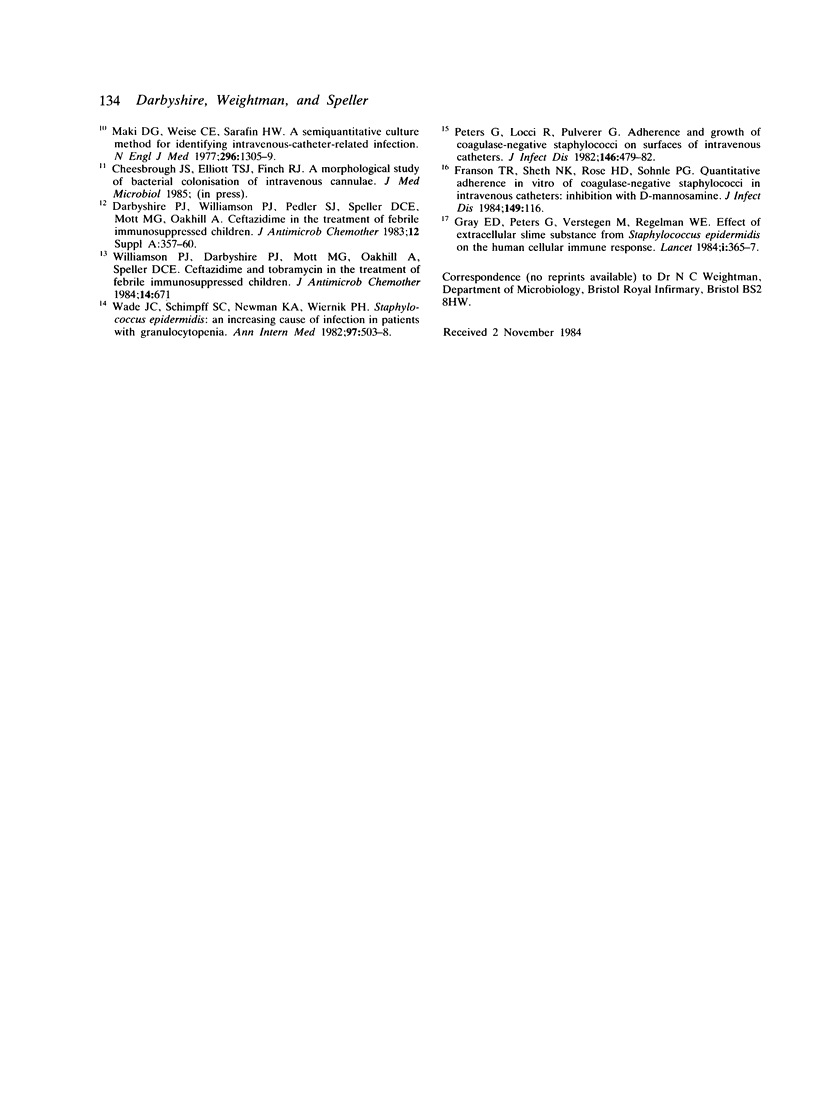Abstract
Forty nine Broviac or Hickman indwelling central venous catheters were inserted in 36 patients with haematological and neoplastic diseases for indications including young age, intensity of treatment, and psychological attitude. Sixteen patients suffered 29 episodes of infection related to the catheter bacteraemia (0.68 episodes per 100 days of catheter use). Infections occurred much more commonly where there was intensive use of the catheter than with relatively light catheter use. Twenty episodes were caused by a single bacterial strain and nine by multiple strains; coagulase negative staphylococci accounted for 51% of the strains isolated. Altogether 72% of infections were cured by antibiotic treatment, which was more likely to be successful in eradicating single than multiple infections. Although infection was common, mechanical problems were a more usual reason for catheter removal. There were no deaths caused by catheter related infection.
Full text
PDF





Selected References
These references are in PubMed. This may not be the complete list of references from this article.
- Blacklock H. A., Pillai M. V., Hill R. S., Matthews J. R., Clarke A. G., Wade J. F. Use of modified subcutaneous right-atrial catheter for venous access in leukaemic patients. Lancet. 1980 May 10;1(8176):993–994. doi: 10.1016/s0140-6736(80)91436-1. [DOI] [PubMed] [Google Scholar]
- Broviac J. W., Cole J. J., Scribner B. H. A silicone rubber atrial catheter for prolonged parenteral alimentation. Surg Gynecol Obstet. 1973 Apr;136(4):602–606. [PubMed] [Google Scholar]
- Darbyshire P. J., Williamson P. J., Pedler S. J., Speller D. C., Mott M. G., Oakhill A. Ceftazidime in the treatment of febrile immunosuppressed children. J Antimicrob Chemother. 1983 Jul;12 (Suppl A):357–360. doi: 10.1093/jac/12.suppl_a.357. [DOI] [PubMed] [Google Scholar]
- Franson T. R., Sheth N. K., Rose H. D., Sohnle P. G. Quantitative adherence in vitro of coagulase-negative staphylococci to intravascular catheters: inhibition with D-mannosamine. J Infect Dis. 1984 Jan;149(1):116–116. doi: 10.1093/infdis/149.1.116. [DOI] [PubMed] [Google Scholar]
- Gray E. D., Peters G., Verstegen M., Regelmann W. E. Effect of extracellular slime substance from Staphylococcus epidermidis on the human cellular immune response. Lancet. 1984 Feb 18;1(8373):365–367. doi: 10.1016/s0140-6736(84)90413-6. [DOI] [PubMed] [Google Scholar]
- Hickman R. O., Buckner C. D., Clift R. A., Sanders J. E., Stewart P., Thomas E. D. A modified right atrial catheter for access to the venous system in marrow transplant recipients. Surg Gynecol Obstet. 1979 Jun;148(6):871–875. [PubMed] [Google Scholar]
- Maki D. G., Weise C. E., Sarafin H. W. A semiquantitative culture method for identifying intravenous-catheter-related infection. N Engl J Med. 1977 Jun 9;296(23):1305–1309. doi: 10.1056/NEJM197706092962301. [DOI] [PubMed] [Google Scholar]
- Peters G., Locci R., Pulverer G. Adherence and growth of coagulase-negative staphylococci on surfaces of intravenous catheters. J Infect Dis. 1982 Oct;146(4):479–482. doi: 10.1093/infdis/146.4.479. [DOI] [PubMed] [Google Scholar]
- Raucher H. S., Hyatt A. C., Barzilai A., Harris M. B., Weiner M. A., LeLeiko N. S., Hodes D. S. Quantitative blood cultures in the evaluation of septicemia in children with Broviac catheters. J Pediatr. 1984 Jan;104(1):29–33. doi: 10.1016/s0022-3476(84)80584-3. [DOI] [PubMed] [Google Scholar]
- Reed W. P., Newman K. A., de Jongh C., Wade J. C., Schimpff S. C., Wiernik P. H., McLaughlin J. S. Prolonged venous access for chemotherapy by means of the Hickman catheter. Cancer. 1983 Jul 1;52(1):185–192. doi: 10.1002/1097-0142(19830701)52:1<185::aid-cncr2820520134>3.0.co;2-r. [DOI] [PubMed] [Google Scholar]
- Sanz M. A., Such M., Rafecas F. J., Martin G., Santas M. Staphylococcus epidermidis infections in acute myeloblastic leukaemia patients fitted with Hickman catheters. Lancet. 1983 Nov 19;2(8360):1191–1192. doi: 10.1016/s0140-6736(83)91234-5. [DOI] [PubMed] [Google Scholar]
- Shapiro E. D., Wald E. R., Nelson K. A., Spiegelman K. N. Broviac catheter-related bacteremia in oncology patients. Am J Dis Child. 1982 Aug;136(8):679–681. doi: 10.1001/archpedi.1982.03970440023006. [DOI] [PubMed] [Google Scholar]
- Sitges-Serra A., Puig P., Jaurrieta E., Garau J., Alastrue A., Sitges-Creus A. Catheter sepsis due to Staphylococcus epidermidis during parenteral nutrition. Surg Gynecol Obstet. 1980 Oct;151(4):481–483. [PubMed] [Google Scholar]
- Wade J. C., Schimpff S. C., Newman K. A., Wiernik P. H. Staphylococcus epidermidis: an increasing cause of infection in patients with granulocytopenia. Ann Intern Med. 1982 Oct;97(4):503–508. doi: 10.7326/0003-4819-97-4-503. [DOI] [PubMed] [Google Scholar]
- Williamson P. J., Darbyshire P. J., Mott M. G., Oakhill A., Speller D. C. Ceftazidime and tobramycin in the treatment of febrile, immunosuppressed children. J Antimicrob Chemother. 1984 Dec;14(6):671–671. doi: 10.1093/jac/14.6.671. [DOI] [PubMed] [Google Scholar]
- Wing E. J., Norden C. W., Shadduck R. K., Winkelstein A. Use of quantitative bacteriologic techniques to diagnose catheter-related sepsis. Arch Intern Med. 1979 Apr;139(4):482–483. [PubMed] [Google Scholar]


